Summary
- Ganoderma butt rot is caused by the fungus Ganoderma zonatum. This fungus degrades the lignin in the lower 4–5 feet of the trunk. It does not cause a soft rot, so the truck seems hard.
- All palms are considered hosts of this fungus. This fungus is not a primary pathogen of any other plant family.
- Symptoms may include wilting (mild to severe) or a general decline. The disease is confirmed prior to palm death by observing the basidiocarp (conk) on the trunk. This is a hard, shelf-like structure that will be attached to the lower 4–5 feet of the palm trunk. However, many diseased palms do not produce conks prior to death.
- A palm cannot be diagnosed with Ganoderma butt rot until the basidiocarp (conk) forms on the trunk, or the internal discoloration of the trunk is observed after the palm is cut down.
- The fungus is spread by spores, which are produced and released from the basidiocarp (conk).
- Conditions that are conducive for disease development are unknown. There are currently no cultural or chemical controls for preventing the disease or for curing the disease once the palm is infected.
- A palm should be removed as soon as possible after the conks appear on the trunk. Remove as much of the stump and root system as possible when the palm is removed, or grind the stump. If neither is possible, monitor the stump for conks, and remove the conks as soon as they form.
- Because the fungus survives in the soil, planting another palm back in that same location is not recommended without special precautions.
Introduction
Ganoderma butt rot is a lethal disease of palms, both in the landscape and natural settings. While the disease is more prevalent in the southern half of the state, where palms are in greatest abundance, it is certainly not restricted to that area. The fungus that causes the disease is distributed throughout Florida, from Key West to Jacksonville to Pennsacola. It is also known to occur in Georgia and South Carolina.
Pathogen and Hosts
The fungal genus Ganoderma is a group of wood-decaying fungi that are found throughout the world on all types of wood—gymnosperms, woody dicots, and palms. There are many different species of this fungus in Florida, but only one is a pathogen of palms. That fungus is Ganoderma zonatum. This fungus does not cause a disease in any other plant family.
In general, if you observe a basidiocarp (conk) on a palm trunk, especially if it is still living, it is probably safe to assume it is G. zonatum and not some other Ganoderma species. Likewise, the Ganoderma species often observed on hardwood trees, such as oak, are rarely observed on living palms. These other Ganoderma species may occur on dead palm trunks and stumps, but they are present simply as saprobes (fungi that live off dead plant material).
All palms are assumed to be susceptible to this disease. While not all palms growing in Florida have been documented with Ganoderma butt rot, at least 65 species of palms have. Those not documented with this disease are not commonly grown and have thus far escaped.
Symptoms, Signs, and Diagnosis
Ganoderma zonatum is a white rot fungus that produces numerous enzymes that allow it to degrade (rot) woody tissue. The fungus first degrades lignin and then cellulose. As the fungus destroys the palm wood internally, the xylem (water-conducting tissue) will eventually be affected. Therefore, the primary symptom that may be observed is a wilting, mild to severe, of all leaves except the spear leaf (Figures 1 and 2). Other symptoms can best be described as a general decline—slower growth and off-color foliage—and more dead lower leaves than would be normal. However, these symptoms alone should not be used for diagnosis of Ganoderma butt rot, since other disorders or diseases may also cause these symptoms.
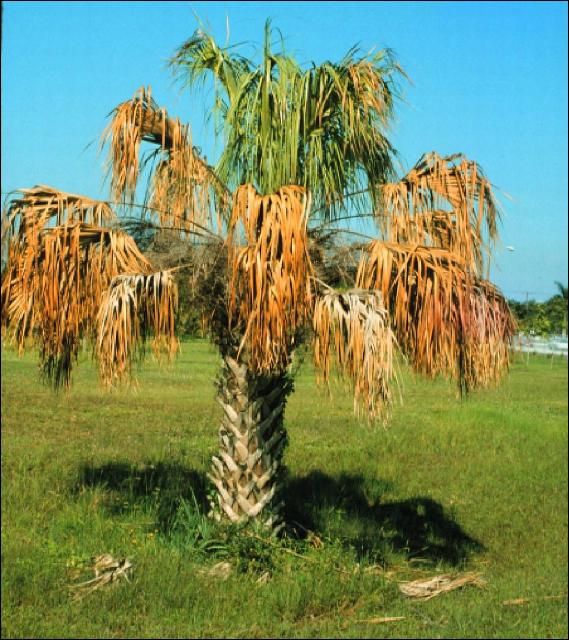
Credit: M. L. Elliott, UF/IFAS
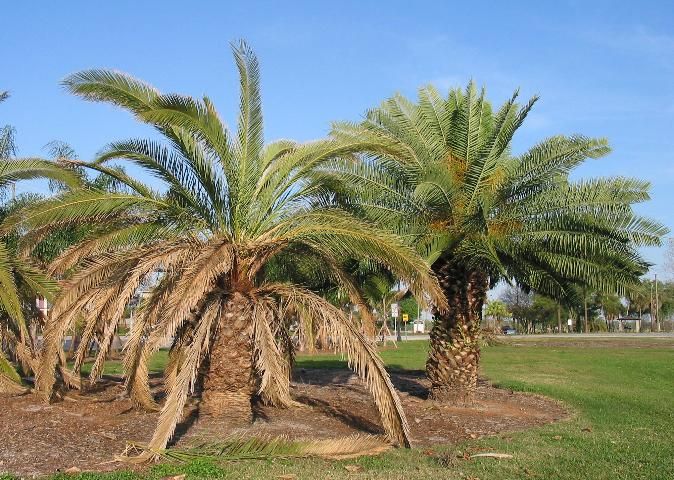
Credit: UF/IFAS
The basidiocarp or conk is the most easily identifiable structure associated with the fungus. The conk originates from fungal growth inside the palm trunk. Figure 3 illustrates different stages in the development of the conk. When the conk first starts to form on the side of a palm trunk or palm stump, it is a solid white mass that is relatively soft when touched. It will have an irregular to circular shape and is relatively flat on the trunk or stump.
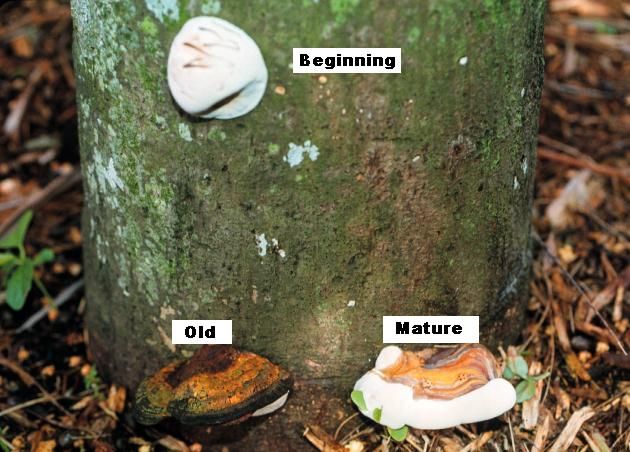 ;
;
Credit: M. L. Elliott, UF/IFAS
As the conk matures, a small shelf or bracket will start to form as the basidiocarp begins to extend or protrude from the trunk. It will still be white, both on the top and bottom surfaces. Eventually, it will form a very distinct shelf-like structure that is quite hard with a glazed reddish-brown top surface and a white undersurface (Figure 4). A mature conk will have distinct zones, hence the name G. zonatum. The conk will have a half-moon shape with the relatively "straight" side directly attached to the trunk.
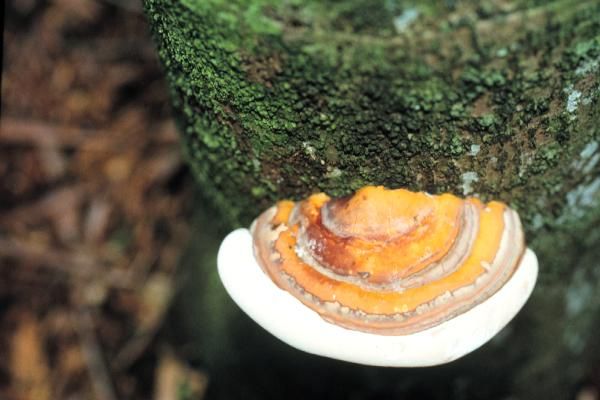 ;
;
Credit: M. L. Elliott, UF/IFAS
If a conk is present on the trunk at the same time the wilt or decline symptoms appear, then it is safe to diagnose Ganoderma butt rot. However, it is quite common for conks not to appear prior to severe decline and death of a palm. In that situation, the only way to determine if Ganoderma butt rot is the cause is to cut cross-sections through the lower 4 feet of the trunk after the palm is cut down (Figures 5 and 6).
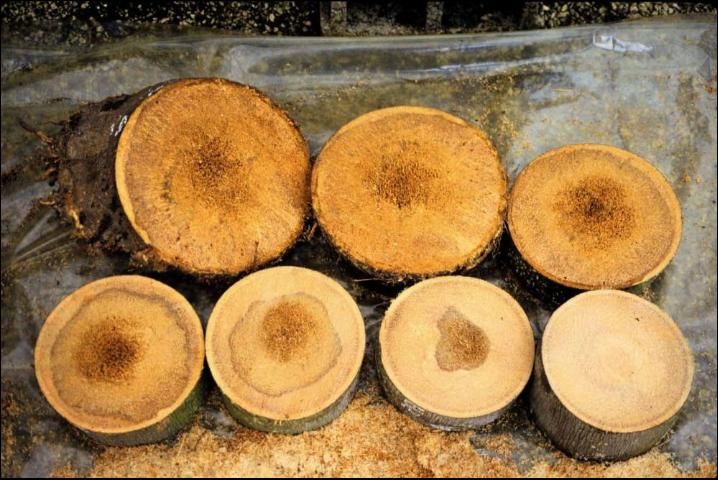
Credit: M.L. Elliott, UF/IFAS
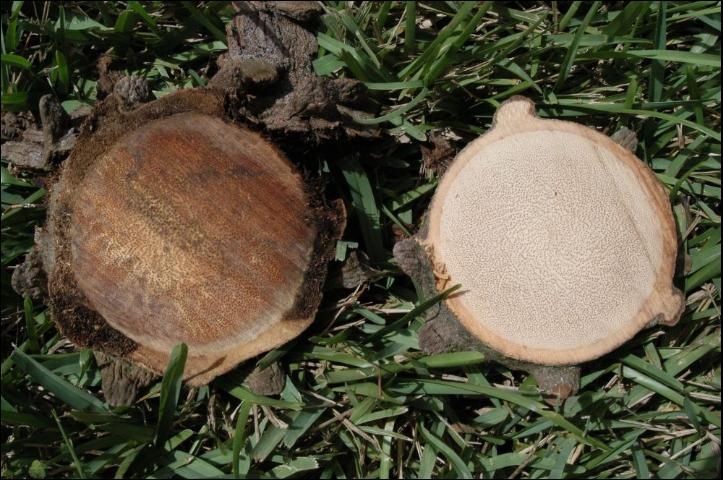
Credit: M.L. Elliott, UF/IFAS
Conks of G. zonatum can be up to 8 inches at their widest point and 2 inches thick. However, conks will take on the shape and size of the area in which they are growing (Figure 7). Microscopic basidiospores are produced in the "pores" present on the underside of the conk. When basidiospores are dropped en mass on a white surface, they will appear brownish-red in color (Figure 8). Objects immediately around a conk that has dropped its spores may appear to be covered with a rusty colored dust. One conk can produce 3 cups of spores.
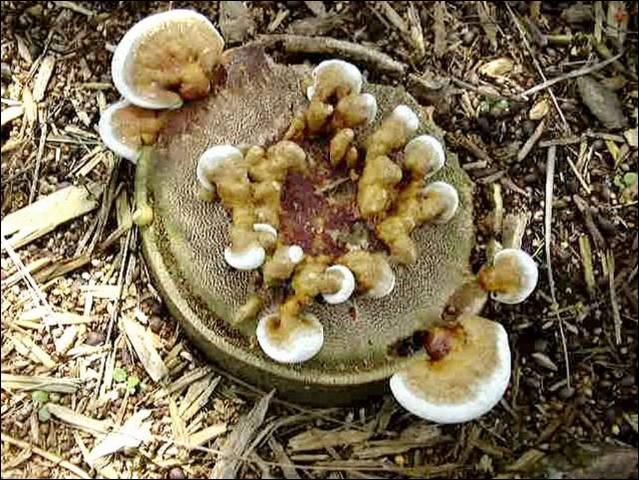
Credit: M. L. Elliott, UF/IFAS
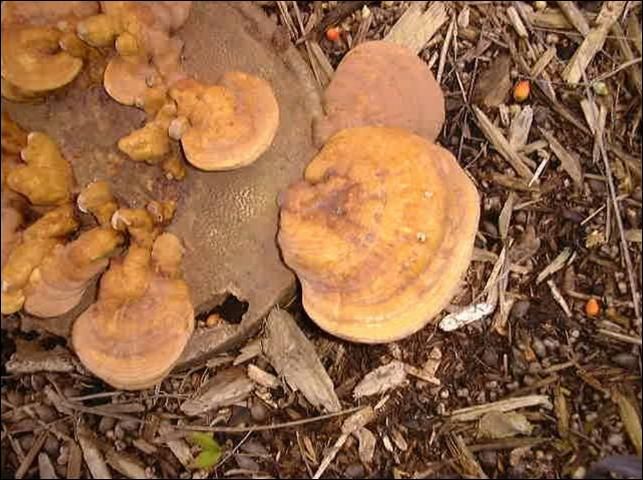
Credit: M. L. Elliott, UF/IFAS
Disease and Fungus Life Cycle
The fungus is spread primarily by the spores produced in the basidiocarp (conk). The spores become incorporated into the soil, germinate, and the hyphae (fungal threads) then grow over the palm roots. The fungus does not rot the palm roots, it simply uses the roots as a means of moving to the woody trunk tissue (Figure 9). Once a palm is infected with G. zonatum, the fungus will move with that palm to the location in which it is transplanted. It is also possible that soil associated with transplanted palms is infested with the fungus.
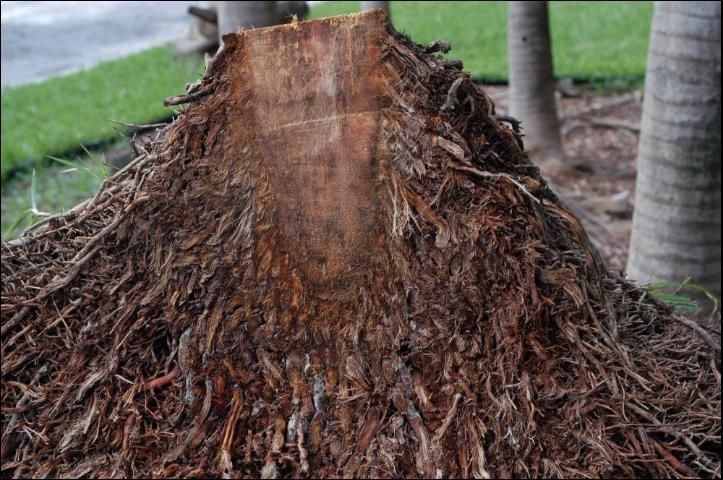
Credit: M. L. Elliott, UF/IFAS
We do not know exactly how many months or years pass between initial infection of a palm and development of the conk. There is no method that can determine if a palm is infected with G. zonatum. Until the conk forms, there can be no confirmation of this disease. Therefore, it is not possible to guarantee that a palm is free of Ganoderma when first planted in the landscape.
Figures 5 is an example of the wood decay and disease progression pattern observed. The fungus colonizes and degrades the palm trunk tissue closest to the soil line first, expands in diameter at the base and moves up the center or near-center of the trunk. Therefore, the disease progression pattern within the trunk is best described as cone-shaped, widest at the soil line and narrowing to a pinpoint.
The location of the conk is where the fungus is emerging from the trunk. This means the degradation is occurring internally as the fungus moves from the lower center of the palm to the outside. Therefore, wounds are not a likely factor in disease initiation. Other external environmental factors associated with the trunk are probably not associated with disease development either, such as too much mulch around the trunk, irrigation heads striking the trunk, flowers or shrubs too close to the trunk, or painting the trunk.
Disease Management
No environmental conditions or landscape management practices have been observed that favor the development of Ganoderma butt rot. The disease occurs in natural settings (palms never transplanted) and in highly-maintained, transplanted landscapes. It occurs on palms that have been maintained very well nutritionally (no nutrient deficiencies) and on palms that were severely stressed by deficiencies. The disease occurs in well-drained settings and in swamps. The fungus has killed trees that had no apparent mechanical injuries and those that had been severely damaged by, for example, weed trimmers. Soil type appears to have no relationship with disease either, as diseased palms have been observed on deep sands (both silica and calcareous), muck (peat), and limestone rock. There has been no discernible pattern to provide clues as to why some palms become infected and die from G. zonatum, and others do not.
In general, the fungus will be located in the lower 4–5 feet of trunk. This means the fungus is not spread with pruning tools since the fungus is not associated with leaves. Also, only the lower trunk portion should not be chipped and used for mulch. If possible, the diseased section should be placed in a landfill or incinerated. The remaining, fungus-free portion of the palm trunk could be chipped and used for mulch in the landscape.
Since basidiospores from the basidiocarps (conks) are probably the primary method of spreading the fungus, palms should be monitored closely, especially after a palm has died or been removed for any reason. The fungus will readily colonize and degrade palm stumps (See Figures 7 and 8). Once the fungus becomes established in this dead wood, it will normally produce conks with millions of basidiospores that are easily moved by wind and water.
Therefore, monitor palms and palm stumps for the conks. Remove the conk and place in a trash receptacle that will be incinerated or delivered to a landfill. Do not place in trash that will be recycled in the landscape. The earlier the conk is removed (i.e., before it becomes a distinct shelf-like structure), the less likely that spores will be released into the environment. If you have never observed Ganoderma butt rot on the property, monitoring the palms once every six months will be adequate. Once you have observed the conks on palms or have a palm cut or fall down for any reason, monitor your palms at least once a month. Also, monitor the entire neighborhood, not just your yard. These spores blow with the wind, so it should be a community effort to reduce the spread of the spores of this lethal fungus.
Once a conk is observed on a palm, the palm should be removed—primarily for safety reasons (Figure 10). This is especially important during the hurricane season. As indicated before, if conks are being produced on a live palm, it means that a significant portion of the trunk is already decayed. These palms are likely to be the first blown down in heavy winds. When you remove the palm, remove as much of the stump and root system as possible. Alternatively, if you cannot remove the stump, then grind-up the stump. This will allow the infected stump material to degrade more quickly. By removing the stump or grinding the stump into smaller pieces, this will help to limit conk formation on any palm trunk material left behind. You should still monitor the site for conk formation, as described in the previous paragraph.
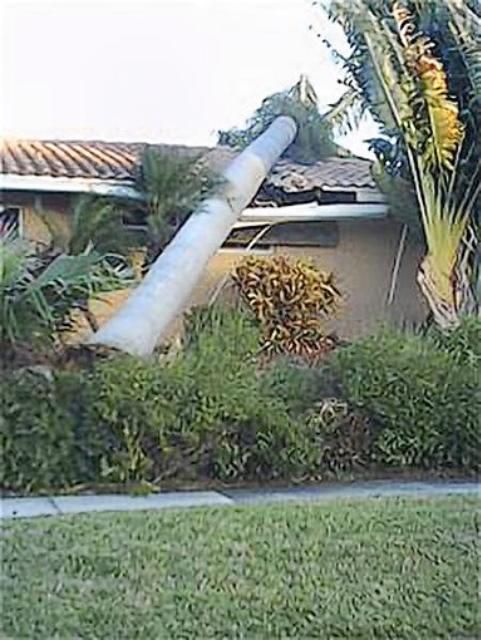
Credit: Ted Conner Landscaping
The fungus survives in the soil. It has been observed that replacement palms planted into the same site where a palm died from Ganoderma butt rot also became diseased and died. Therefore, replanting with another palm is risky. No other plant families (e.g., pines, oaks, woody shrubs, etc.) are affected by G. zonatum—only palms. In other words, replacing the Ganoderma-diseased palm with any other plant except a palm would be a wise choice.
We do not know how long you should wait before it is safe to plant another palm in a Ganoderma-infested site. We can say that the time is measured in multiple years, not months, since the fungus is probably capable of living in the soil almost indefinitely.
Selected References
Elliott, M. L. and T. K. Broschat. 2001. "Observations and pathogenicity experiments on Ganoderma zonatum in Florida." Palms 45: 62–72.
Flood, J., P. D. Bridge, and M. Holderness, eds. 2000. Ganoderma Diseases of Perennial Crops. Wallingford, U.K.: CABI Publishing.
Gilbertson, R. L., and L. Ryvarden. 1986. North American Polypores. Oslo, Norway: FungiFlora A/S.
Miller, R. N.G., M. Hoderness, P. D. Bridge, G. F. Chung, and M. H. Zakaria. 1999. "Genetic Diversity of Ganoderma in Oil Palm Plantings." Plant Pathology 45: 595–603.